This past weekend was Panama’s independence day from Colombia. Christine and I, along with apparently everyone else in Panama City, escaped out from the muggy, humid November weather (it’s the rainiest part of the year for us now) to cooler climes in the country. In our case it was the famously-expatriate-filled town of Boquete, which despite having been a Panamanian city for generations, has been steadily filling with global expats for the past thirty years – starting adventure, hiking, and coffee farm tours left and right.
We found a truck-bed style RV unit on AirBnB for a good price and booked it ASAP – rooms fill up fast at this time of year with Panama City emptied out. I found a company called Boquete Outdoor Adventures (BOA) that offered two day combo trips and booked that, too. I’m the one at home most of the days while Christine’s at work so I took care of most of the planning for this one.
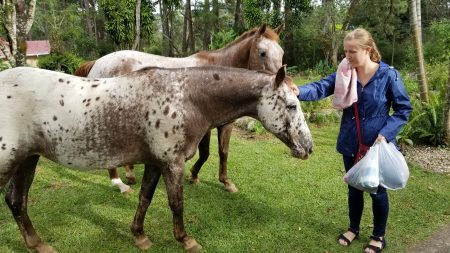
Christine meets two of the ranch’s four horses – these two had free range of the grounds during the day
With Riba staying at Auntie Deb’s again, we left early Thursday morning for the long, dull bus ride. It takes about 6-7 hours of driving to reach the large city of David, where you have to transfer to a smaller local bus for a final hour long ride to Boquete. Uneventful other than the loud, explosion filled Spanish-dubbed movies playing through the loudspeaker system the entire time, I was able to understand the plot of “Kong” pretty easily.
Thankfully, a taxi ride from the center of the delightfully cool and temperate town was only $3 for the two of us; despite taxi drivers probably rubbing their hands together with excitement at the prospect of new tourists in town (Uber is only in Panama City, nowhere else). We were greeted by our AirBnB host who showed us the hobby farm’s animals – horses, four dogs, chickens, and an eerie-sounding yet adorable goose named Alejandro.
We were able to catch a ride back into town the following morning at 7am with the owner of BOA, Jim – who happened to only live a half mile away from our AirBnB – sweet! He’s from the USA but has been living in Boquete for a decade and knew all the good dining spot and offered some camaraderie on living in the country. After grabbing a quick breakfast up the main street and passing by the first of the Independence Day parades (high schools only do female majorettes and drum-guys here vs a full band, at least that I’ve seen so far) we were on the bus, heading westward towards the Costa Rica border and the whitewater rafting river.
An hour later we were suited and helmeted up and being divided up into groups of 4 or 6, each boat with a Panamanian guide and boat-rudder. Christine and I were paired with a Dutch couple, Hans and Wietske, who had come to Panama on an insanely-cheap impromptu holiday when they saw that round trip tickets from Amsterdam were only 340 euro per person. To put in perspective, my one-way ticket from Milwaukee to PC was $450. Argh!
The rapids were somewhere between class 3 and 4 we were told, and it made for a hard-paddling experience for our under-powered crew of 4+rudder vs most of the other four rafts in play with 6+rudder. We contented ourselves with being at the back of the pack where I used the waterproof S8 to take a few photos…holding, very, very tightly to it. We saw some white birds – “gallsa” we were told – and Christine saw a large chameleon in a tree. No monkeys, sadly, but we were a pretty loud bunch of 30 or so people down the river.
The guides/rudders fed us well on Turkey or Ham sandwiches, fruit juice, and cookies – a high caloric lunch of champions about halfway through the ride. The second half was a little wetter (of course it rains just as much in Boquete as it does in PC – it’s just not as hot) and a little wider with more farmland and open areas. At this point we were within a stone’s throw (literally, according to this GPS route of the trip I made) of the Costa Rican border so apparently the guards keep the terrain a lot more clear here. After 17 kilometers, we took out in a drizzle next to a pickup truck that was being dragged, then pushed, out of the river (with a woman on the phone inside it!) by a heavy duty farm tractor. As there were no roads anywhere around us I wondered how this woman had gotten stuck out there in the first place. They made it out after about 10 minutes of trying while the rafting group drank cold beers from the bus and watched. They had it under control it seemed.
We had a delicious dinner at Jim’s favorite place in town, RetroGusto, owned by an Italian friend of his, the ebullient head chef David Ca’re. We’d already had lunch yesterday at his small bistro, Otto, but everyone was saying that hands down, RetroGusto was the best fine dining in town. David remembered meeting me yesterday and got us some great dishes, finished off with a free digestif he served us. The power went out as we were finishing our bottle of Spanish wine, so we sat in the light of the tabletop candles and emergency lighting and listened to folks chat in good humored Spanish. Power outages are not frequent, but common enough that no one thinks twice about them, even while at a restaurant. As long as the owner has plenty of candles on hand, that is!
We were able to easily get a taxi back up to our camper ($4 at night, and it was a holiday so we didn’t mind paying beyond the regular rate) and I looked out over the darkened city and read my book in a lawnchair. After an hour or so I heard a soft thump as the power in the house behind the camper restarted, and the lights flickered back on in a patchwork over the course of 5 seconds or so below me, like in a movie. Which was good, because the RV’s tiny battery was already almost dead according to the tester on the wall!
The following morning Christine was feeling under the weather, so I rose and hiked down a nearby local path in order to reach the town in record time; a mere 20 minute hike from doorstep to BOA’s office. The rough but serviceable footpath seemed like it would be extremely useful to other AirBnB tourists on this hill, so I took a few moments yesterday to add it onto OpenStreetMap as the “Volcancito Shortcut Path”.
Our small, seven person group was picked up by a young Panamanian man named John who spoke flawless American English – he said he’d gone to high school in Tennessee. He drove our mini-bus a few clicks north to the locally-famous Pipeline Trail, named not for oil pipes like the one we’d already done last month in Gamboa but for supplying Boquete with almost all of its water. On the way he pointed out the small color-coded coffee satellite farm buildings, some brown and some blue, colored because in the old days the coffee pickers were poor native children who had to start picking coffee before they knew how to read names or numbers and could only differentiate which buildings and properties were “theirs” with colors. Even though Panama has child labor laws now the buildings are old and now the color scheme is traditional, so no one paints them differently.
It was a great hike through the cool forest, crisscrossing over a small river three times and as many as fourteen 120cm diameter pipes leading back toward the city behind us. We didn’t see many animals (beyond a mating heap of wriggling caterpillars and some African Killer Beehives through the trees on a research farm nearby, used as pollination testing for climate change’s future effects on the local coffee plants. We didn’t go even close to the huge sign tacked onto a nearby tree that said “NO PASE, PELIGROSO” on it in elegant cursive letters. Killer Bees? You don’t have to tell me twice, sign.
It was about a 7km round trip hike up to the 150 meter tall waterfall at the end of the canyon. Some of us, myself included, went up to it, climbing over slippery, moss-covered rock scree for the last 20 meters to where the water hit the stone. All and all, a great little hike, especially with a nature-knowledgeable guide like John.
I met up with Christine at David’s third and final Boquete restaurant, a Neopolitan pizza restaurant right next to RetroGusto. The $6 margherita pizza we each had was one of the finest personal-sized pizzas I’ve ever eaten. We even bought and split a third it was so good. My god I’m going to miss the food here in Boquete when I’m back in Panama City!
The final event of the trip, the Finca Dos Jefes organic coffee farm tour, was equally informative. We were picked up from BOA’s office after lunch by a Panamanian woman named Amy, who drove us back up the hills north to her employer Richard’s farm. Twenty years ago, he and his wife – the other jefe (boss) of the Dos Jefes in the name – had moved from the USA to Boquete with the early expat boom and on a whim, started an environmentally sound small-batch organic coffee farm.
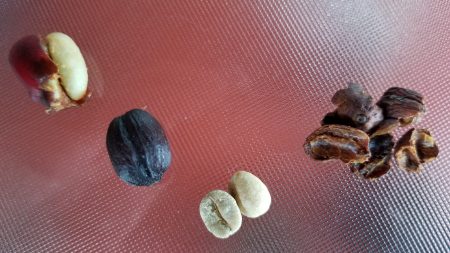
From Top left – wet, slimy coffee beans in a raw cherry. Dried cherry ready to be shelled. Dried beans, and empty shells (now used to make tea!)
Amy knew quite a bit about her adopted farm and showed us around the silent, tall coffee bushes and nitrogen fixing citrus trees. We learned about the drilling beetles that could ruin the coffee cherries, and the “grim reaper” of coffee, leaf rust. As an organic farm, Dos Jefes had their work cut out for them planning and implementing fixes for these pests that wouldn’t jeopardize their organic label. We stopped by their storage room and I saw dozens of boxes bound for some place in Fort Wayne, Indiana. USA and Europe are great export partners for the farm, Amy explained – something new replacing “Fair Trade” coffee called “Direct Trade” where the end cafes and restaurants find a specific farm they like and buy the unroasted beans directly, cutting out the middleman. Amy told us that for small farms to sell to Panama’s major roaster chain, Duran Cafe, they’d be getting approximately $3 a pound. Their main German roaster partner, on the other hand, selected Dos Jefes specifically for their flavor and organic mission and pays them more than $10 a pound. Happy German coffee drinkers, happy Richard and his wife, and happy coffee pickers.
We didn’t see any of those pickers around since it was still the holiday weekend, but the plantation foreman’s twin 9 year old daughters capered around Amy in beautiful native dresses, helping her however she asked. She told us that she’d started paying the girls $1 each per tour they helped her with, and they were putting the money towards schools supplies. They carefully and proudly served us our complimentary Medium and Dark roasted french press blends, too.
Afterward we drank our coffee, I volunteered/was selected as our group’s roaster – Amy said, well since you’re the only guy in a group with 9 women, I guess we can take pity on you. Christine said “He’s been talking nonstop about being the roaster for weeks now, too.” I like my tours to be thorough – if something is an option, I want to do it!
The process was, much like cooking, all about time and temperature. Amy had a stopwatch and was adjusting the gas flame valves carefully at specific times for the Dark Roast I’d be helping to make. I poured in the four pounds of beans into the rotating hopper when the temperature of the drum was specifically 420 Fahrenheit, and we were off to the races. Amy monitored the time and temp and told me when to adjust the heat, open a valve to let the heat out faster, and when to take out the “core sample” of beans for inspection. After about 15 minutes the roast was finished – the center line of the beans snapping and popping like popcorn as we drained the drum into a cooling tray with mechanical rotating arms to expose more of the beans to the cool mountain air. Christine has a cool slow-motion video of the beans being dumped; I hope she posts that on her website and will add a link if she does!
We bought a couple of bags of beans as gifts for family and Amy drove our group back down the hill to town. It was already getting dark – and was a bit rainy – so we had time for one last dinner in town. We turned in early, but not before confirming with the wonderful Jim that he could give us and our bags a lift into town the next morning to catch an early bus back to PC. It was a long ride – we didn’t get back to PC until 5:30pm that evening – but we already miss the cool mountain air of Boquete!
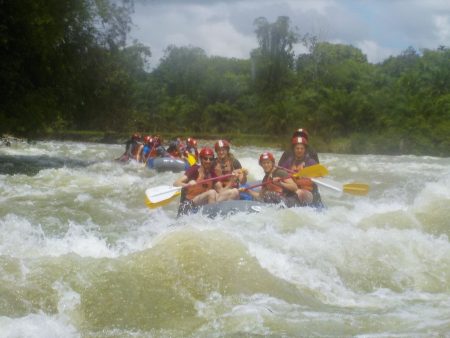
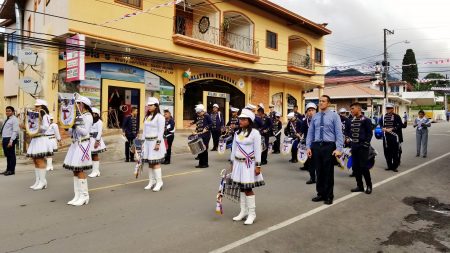
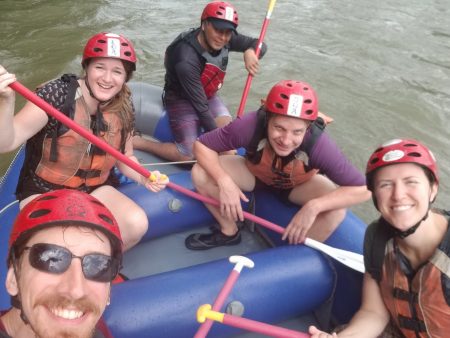

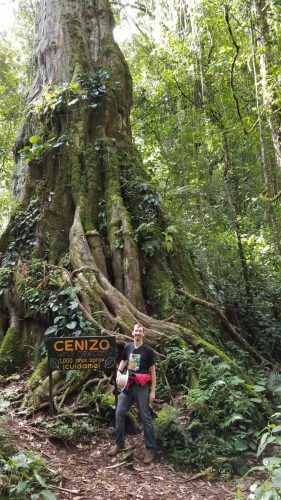
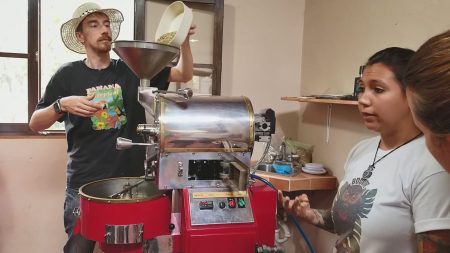
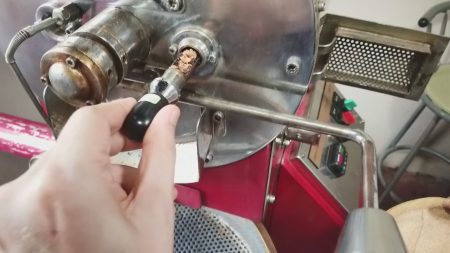
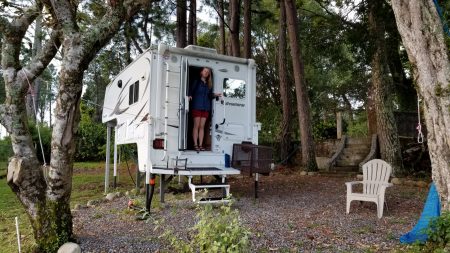


Zach-
I am thoroughly enjoying reading about your adventures. You have such an eye for detail (like taking time to make an Open Street Map contribution). Sounds like you are making memories you’ll remember for life.
Ryan
Glad to hear you enjoyed it! I figured only a fellow computer nerd would truly appreciate the addition to OSM – frankly, it’s the only way you can get accurate walking directions here in Panama City. Google’s are completely inaccurate and often recommend walks that would take an extra 5km and 50 minutes instead of the right way which takes 10 minutes. They’re just overly cautious and don’t write in perfectly usable routes…OSM will send you on the actual shortest walking route!